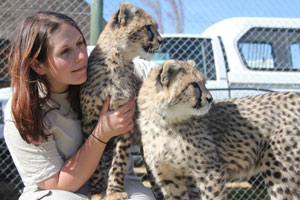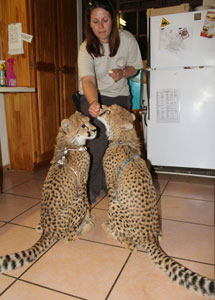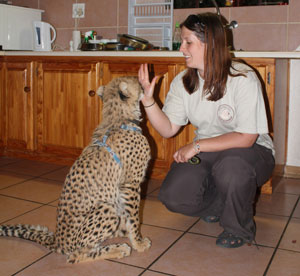Reprinted with permission from the KPCT Blog
Editor's note
If you have experienced the power of
clicker training, you know it has the potential to save animal lives. One
Karen Pryor Academy (KPA) Certified Training Partner (CTP),
Jade Fountain, has demonstrated that
clicker training can help save an entire species! Jade recently journeyed to South Africa, utilizing skills and knowledge gained through the
KPA Dog Trainer Program to help safeguard the world's fastest land animal—the cheetah.
The cheetah is among the many species at risk of
extinction. Threatened by human persecution, habitat loss, poaching, and competition, the number of cheetahs has decreased drastically, with only 7,500 left in the world. One of the largest threats to cheetahs is conflict with farmers who see cheetahs as pests and trap, poison, or shoot them. Action to safeguard the species must be taken or cheetahs will become the latest casualty in the mass extinction of species.
As part of this effort, Jade helped train cheetah cubs to be comfortable with people. With this accomplished, the cheetahs can travel to schools, farms, and communities where they can inspire change by offering people the rare opportunity to interact with them. Here, Jade tells us about her work with these magnificent animals.
What led to your interest in protecting cheetahs?
I'm passionate about conservation. I have worked with endangered species programs in Australia for the past four years as a zookeeper, including the Save the Tasmanian Devil Program and the Brush-tail Rock Wallaby Recovery Program. As a professional trainer, I have a very keen interest in using behavioural management to improve welfare and reduce stress in captive breeding programs. The opportunity to travel to South Africa and work with cheetahs (and hand-raise orphan rhino calves, handle vultures, and be involved in rehabilitation) was hugely rewarding.
Tell us about how you became involved. Why did they select you?
I applied for the position when it came up in a zookeeping job list, and I was selected based on my qualifications and background in zookeeping, behaviour, and training. Being prepared to give up normal sleeping habits to bottle-feed the young cheetah cubs and work long hours, and my experience hand-raising kangaroo and possum joeys were all pluses.
How had these cheetahs been trained traditionally?
The two facilities I worked at had different training methods. Progression toward errorless learning and effective behaviour change is occurring slowly and is moving toward realizations like there is no need to flick a cub in the nose—it doesn't provide information to the learner and can increase aggression.
It was essential to me to introduce the science of how animals learn, teach how important it is to reinforce desired behaviour and ignore/redirect undesirable behaviour, and spread the influence of force-free training. A highlight of my trip was seeing both the cubs' reaction to clicker training and the complete change in their behaviour with positive
reinforcement.
What was the purpose of training the cheetah cubs? Can you describe your training program?
The cheetah cubs are ambassador animals, which means they need to feel comfortable and safe meeting new people, encountering novel situations, and travelling to different places to educate people. Asking people to interact, touch, and see for themselves what a cheetah is really like inspires change in attitudes toward persecution and poaching of these athletic cats.
We trained the cheetahs to sit, hop on to scales, station on platforms, wear harnesses, walk on collar and lead, use crates, and feel comfortable with veterinary examinations. I worked to implement positive reinforcement through use of clicker training. We used elements of the cheetahs' daily diet (a variety of different meats: springbok, elephant, kudu, or warthog) as rewards. The cubs learned very quickly, purred during the sessions, and changed their "teenage" attitudes toward the handlers.
What were some of the challenges you encountered?
The biggest challenge in training was probably getting all of the staff on the same page. Figuring out how to run a
training session with three of the cubs in the room at the same time was also interesting and tested my training skills,
timing, and rates of reinforcement. I think TAGteach helped me overcome these challenges and others I encountered.
What were the results of your training?
Prior to the training, some of the cubs had been giving the handlers trouble with stalking and pouncing, and with aggression. These behaviours included tantrums when the harnesses came out, a lot of hissing, and mouthing. We began clicker training during mealtimes, starting with putting "sit" on
cue and getting the cheetahs to target our hands.
Within three ten-minute sessions, we saw a big change in the cubs' behaviour. As we progressed, the aggression and stalking dropped off, the cheetahs became more interactive with handlers, and the animals were easier to handle—they even lay still for vet examinations. The purrs coming from the cheetahs were extremely rewarding. Clicker training was successful in reducing their reactivity and aggression toward keepers. The cheetahs have been very responsive and easy to handle, walk, and interact with ever since.
Tell us about the impact on the staff. Will they be making any changes as a result of the success you had?
The last day that I worked with the cubs at the facility there were a lot of huge moments and some tears for the successes. It was certainly a big moment when the cubs looked up at their handlers and purred on approach—relaxed and willing to come over. This means that these cubs will be able to graduate from the ambassador program and help the conservation effort for their species.
Staff members have taken on clicker training, figured out the daily rations from the cubs' diets that can be allocated to training, and written a plan to get the cubs to be the most successful ambassadors that they possibly can be. Positive reinforcement and clicker training have already made a big difference in the program.
Do you think being a graduate of the KPA Dog Trainer Program helped you train the cheetah cubs successfully? How so?
I think that being a KPA graduate has given me necessary skills that apply to whatever species I work with. One of the skills that helps me most in teaching others is the TAGteach training that I learned during the KPA Dog Trainer Program. KPA helped me improve many mechanical skills and I am proud to demonstrate them for such important purposes.






